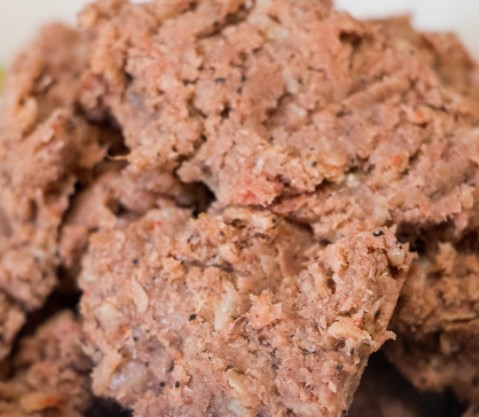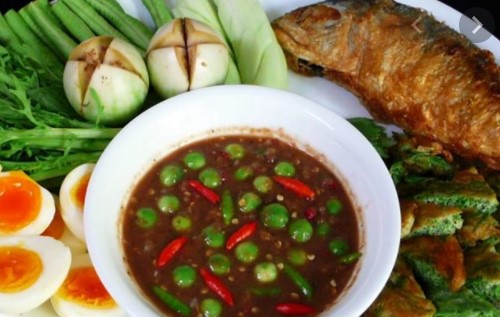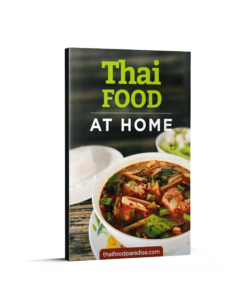Shrimp Paste in Thai Food: What Is It?

When you start to look at a range of Thai recipes, you’ll note that shrimp paste turns up a lot. Known to the Thais as kapi (กะปิ), shrimp paste is an important part of many dishes, particularly from the South of the country. This article aims to explain what shrimp paste is and its importance in Thai cuisine.
Shrimp Paste: A Quintessential Southern Thai Condiment
Shrimp paste is a fermented condiment produced by crushing shrimp and mixing it with salt for weeks at a time. Cooks from the South of Thailand love to use shrimp paste to add a funky savory hit to curry pastes and chili dips (nam prik).

One of the most famous uses of shrimp paste is to make nam prik kapi, which is a chili dip served with steamed vegetables, an omelette with cha om, and fish. The dip is extremely pungent on the nose and strong in flavor too. Despite being a Southern Thai dish, it’s eaten widely all over the country.
What you might not know is that the recipe for one of Thailand’s most popular curry pastes, red curry paste, has shrimp paste in it. This is an authentic traditional part of red curry paste that I don’t advocate for omitting unless you are allergic to shrimps or can’t eat them for dietary reasons.
Don’t be put off by the smell of shrimp paste. Similar to fish sauce, the taste is nowhere near as strong as the smell. Furthermore, the overall pungency of shrimp paste tends to mellow when you cook it.
Are All Shrimp Pastes The Same?
Not at all, and it’s really important to remember that if you’re cooking Thai food you must actively seek out kapi, the Thai version of shrimp paste. This type of paste has the consistency of peanut butter and is slightly oiler than other types of shrimp paste.
It’s worth noting that several different countries in Southeast Asia all make their own unique versions of it, from Bagoong alamang in Philippines to Belacan in Malaysia. These are all not substitutes for each other.
In fact, an interesting paper on kapi goes into detail about this paste as a source of umami in Southeast Asia. Different countries use different amounts of salt (or none at all) in the fermentation process. Furthermore, the time taken to ferment differs across nations. Kapi takes two months, if you are curious. Therefore, the end product tends not to be the same.
It’s likely fermented shrimp products have been produced in Southeast Asia since around the 15th century and probably earlier. It’s thought that the ethnic Mon and Cham people first came up with the method of fermenting shrimp into a paste. They used to lay the paste out the dry in the sun on bamboo mats.
While the end goal is similar — delivering a whack of umami richness to food — the slight differences in technique are why I only advocate trying to find Thai kapi. The species used to make kapi is either normal shrimp or krill, which is another crustacean in the shrimp family.
Where To Buy Thai Shrimp Paste
You can easily find real-deal Thai kapi in many Asian grocery stores. Conveniently, you can also get it on Amazon. Amazon stocks the brand known as “Kapi Thai”, which is popular in Thailand and tastes great. Buy this one and you can’t really go wrong.

 Storage
Storage
The nature of how it’s made means that unopened kapi has an extremely long expiration date. If you open the jar, it will still last a really long time; several months to a year is fine. Just make sure to tightly close the jar when you’re not using it and it’s guaranteed to keep its freshness.
Substitutes for Shrimp Paste
It’s very difficult to replicate the flavor of shrimp paste because it’s unique. If for dietary reasons you cannot use it in your food or any other seafood products, the best thing I can think of is to try some normal table salt mixed in with Golden mountain seasoning sauce. Better still, replace the table salt with a teaspoon of MSG and you’ll get even more of an umami hit.
I lived in Thailand for a few years during my 20s during which time I fell in love with Thai food. Along with my Thai partner, I cook and eat tasty Thai dishes 3 or 4 times per week. I’m here to bring you recipes, Thai food tips, and suggested cookware for making Thai food.

